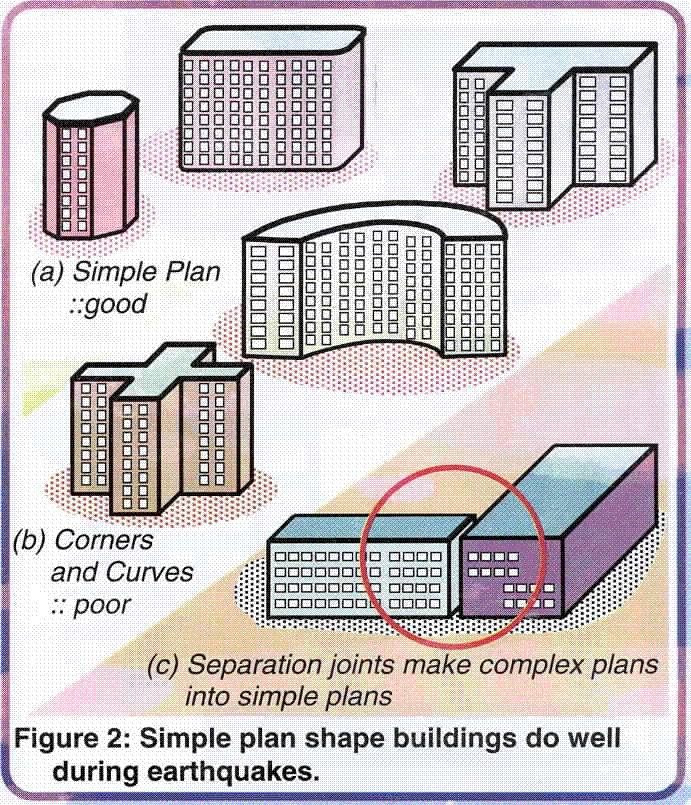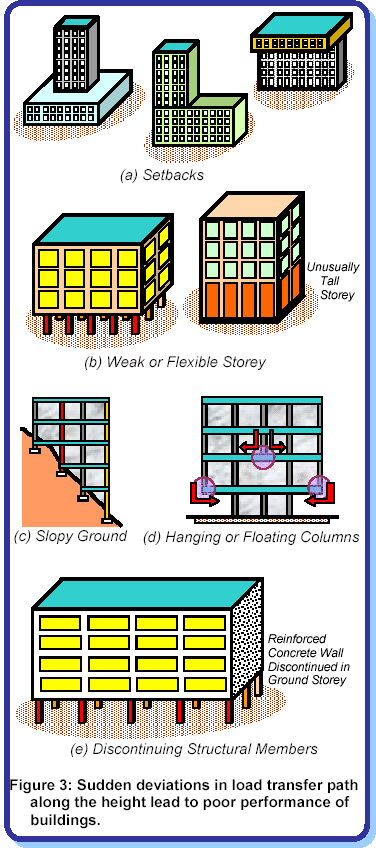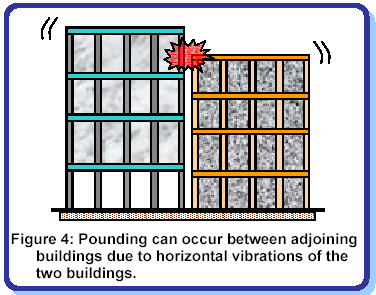 |
Vol. 10, No. 1 October - December 2004
|
|
IITK-BMTPC
EARTHQUAKE TIPS 6: LEARNING EARTHQUAKE DESIGN AND CONSTRUCTION How Architectural Features Affect
Buildings During Earthquakes “If we have a poor configuration to start with, all the engineer can do is to provide a band-aid - improve a basically poor solution as best as he can. Conversely, if we start off with a good configuration and reasonable framing system, even a poor engineer cannot harm its ultimate performance too much.” Architectural Features
Horizontal Layout of
Buildings: In general, buildings with simple geometry in plan
(Figure 2a) have performed well during strong earthquakes. Buildings with
re-entrant corners, like those U, V, H and + shaped in plan (Figure 2b),
have sustained significant damage. Many times, the bad effects of these
interior corners in the plan of buildings are avoided by making the
buildings in two parts. For example, an L-shaped plan can be broken up into
two rectangular plan shapes using a separation joint at the junction (Figure
2c). Often, the plan is simple, but the columns/walls are not equally
distributed in plan. Buildings with such features tend to twist during
earthquake shaking. A discussion of this aspect will be presented in the
upcoming IITK-BMTPC Earthquake Tip 7 on How Buildings Twist During
Earthquakes. Vertical Layout of Buildings: The earthquake forces developed at different floor levels in a building need to be brought down along the height to the ground by the shortest path; any deviation or discontinuity in this load transfer path results in poor performance of the building. Buildings with vertical setbacks (like the hotel buildings with a few storey wider than the rest) cause a sudden jump in earthquake forces at the level of discontinuity (Figure3a). Buildings that have fewer columns or walls in a particular storey or with unusually tall storeys (Figure 3b), tend to damage or collapse which is initiated in that storey. Many buildings with an open ground storey intended for parking collapsed or were severely damaged in Gujarat during the 2001 Bhuj earthquake. Buildings on sloppy ground have unequal height columns along the slope, which causes ill effects like twisting and damage in shorter columns (Figure 3c). Buildings with columns that hang or float on beams at an intermediate storey and do not go all the way to the foundation, have discontinuities in the load transfer path (Figure 3d). Some buildings have reinforced concrete walls to carry the earthquake loads to the foundation. Buildings, in which these walls do not go all the way to the ground but stop at an upper level, are liable to get severely damaged during earthquakes.
Adjacency of Buildings: When two buildings are too close to each other, they may pound on each other during strong shaking. With increase in building height, this collision can be a greater problem. When building heights do not match (Figure 4), the roof of the shorter building may pound at the mid-height of the column of the taller one; this can be very dangerous.
Building Design and
Codes… Resource Material
Lagorio,H,J, (1990), EARTHQUAKES An Architect’s Guide to Non-Structural Seismic Hazard, John Wiley & Sons, Inc., USA. This release is a property of IIT Kanpur and BMTPC NewDelhi. It may be reproduced without changing its contents and with due acknowledgement. Suggestions/comments may be sent to: eqtips@iitk.ac.in. Visit www.nicee.org or www.bmtpc.org, to see previous IITK-BMTPC Earthquake Tips. September 2002
|

 Size of Buildings:
In tall buildings with large height-to-base size ratio (Figure 1a), the
horizontal movement of the floors during ground shaking is large. In short
but very long buildings (Figure 1b), the damaging effects during earthquake
shaking are many. And, in buildings with large plan areas like warehouses
(Figure 1c), the horizontal seismic forces can be excessive to be carried by
columns and walls.
Size of Buildings:
In tall buildings with large height-to-base size ratio (Figure 1a), the
horizontal movement of the floors during ground shaking is large. In short
but very long buildings (Figure 1b), the damaging effects during earthquake
shaking are many. And, in buildings with large plan areas like warehouses
(Figure 1c), the horizontal seismic forces can be excessive to be carried by
columns and walls. 

